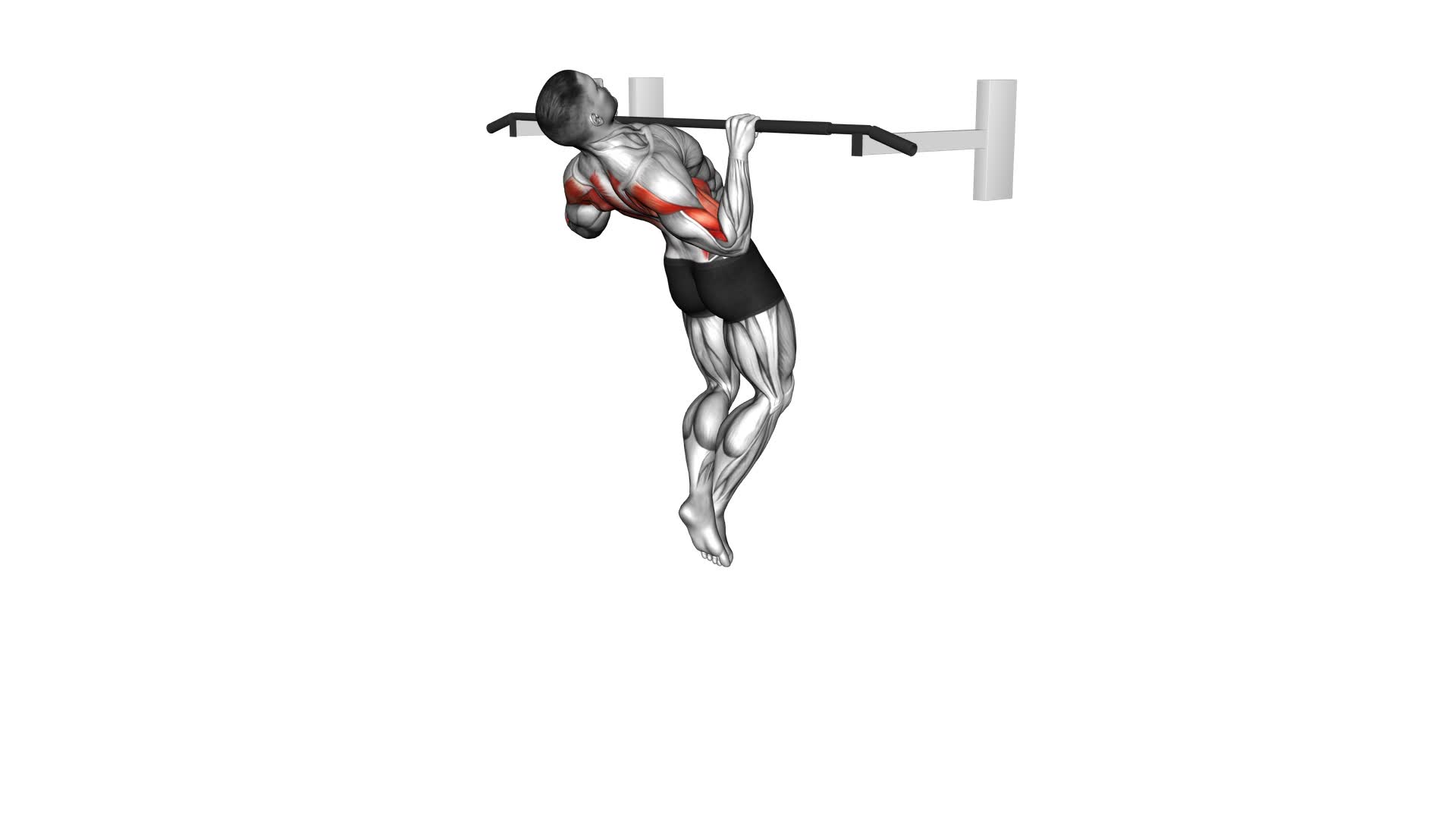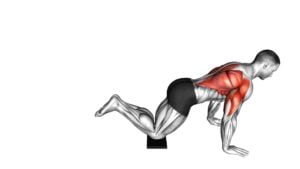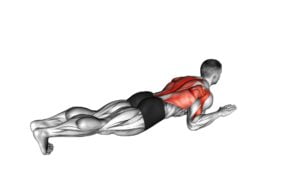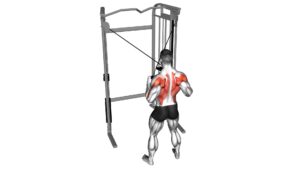Rocky Pull-up Pulldown – Video Exercise Guide & Tips

Are you ready to take your upper body strength to the next level?
Watch This Exercise Video
The Rocky Pull-up Pulldown is here to help you achieve just that.
This dynamic exercise targets your back, arms, and core, giving you a full body workout in one move.
In this video exercise guide, we'll show you the proper form and technique, equipment needed, modifications and progressions, common mistakes to avoid, and essential tips for a successful workout.
Get ready to rock your pull-ups and pulldowns!
Key Takeaways
- The Rocky Pull-up Pulldown targets multiple muscle groups including the back, shoulders, and arms.
- Proper form and technique, such as maintaining correct body alignment and engaging core muscles, are essential for maximizing the benefits of this exercise.
- Engaging the core muscles and maintaining good posture during the exercise help enhance core stability and overall muscle activation.
- Proper breathing techniques, such as inhaling deeply and exhaling fully, help maintain control, stability, and optimize oxygen intake for maximum benefits.
Benefits of the Rocky Pull-up Pulldown
You can experience several benefits from incorporating the Rocky Pull-up Pulldown into your workout routine. This exercise targets multiple muscle groups, including your back, shoulders, and arms. By engaging these muscles, you can build strength and increase your overall upper body power. Additionally, the Rocky Pull-up Pulldown helps improve your grip strength, which is essential for various activities such as rock climbing or carrying heavy objects.
Another benefit of this exercise is that it can enhance your posture. The Rocky Pull-up Pulldown targets the muscles in your upper back, which are responsible for maintaining proper posture. By strengthening these muscles, you can reduce the risk of developing poor posture and related issues like neck and shoulder pain.
The technique of the Rocky Pull-up Pulldown is relatively straightforward. Start by gripping the pull-up bar with your hands slightly wider than shoulder-width apart. Then, pull your body up towards the bar, squeezing your shoulder blades together as you do so. Lower your body back down with control and repeat for the desired number of reps. Remember to engage your core and maintain proper form throughout the exercise.
Incorporating the Rocky Pull-up Pulldown into your workout routine can provide numerous benefits, including increased upper body strength, improved grip strength, and enhanced posture. By following the correct technique, you can maximize the effectiveness of this exercise and achieve your fitness goals.
Proper Form and Technique
To perform the Rocky Pull-up Pulldown with proper form and technique, it's important to focus on correct body alignment. Keep your back straight, shoulders down and back, and engage your core muscles throughout the exercise.
Additionally, be mindful of your breathing, exhaling as you pull down and inhaling as you release.
Correct Body Alignment
Maintain proper body alignment throughout the Rocky Pull-up Pulldown exercise to ensure optimal form and technique. Body posture plays a crucial role in maximizing the effectiveness of this exercise. Keep your spine straight and shoulders pulled back to engage the muscles in your back, chest, and shoulders.
Avoid rounding your shoulders or arching your back, as this can lead to improper muscle activation and potential injury. By maintaining correct body alignment, you'll effectively target the intended muscle groups and minimize strain on your joints. This won't only enhance your overall performance but also reduce the risk of muscle imbalances and postural issues.
Now, let's move on to the next section where we'll discuss the importance of engaging your core muscles.
Engaging Core Muscles
To engage your core muscles properly in the Rocky Pull-up Pulldown exercise, focus on maintaining a stable and strong core throughout the movement. This will help ensure proper form and maximize the benefits of the exercise. Here are some tips to help you engage your core muscles effectively:
- Keep your abdominal muscles tight throughout the exercise.
- Imagine pulling your navel toward your spine to activate your deep core muscles.
- Maintain good posture with your shoulders back and down.
- Avoid arching or rounding your back, as this can put unnecessary strain on your spine.
- Engage your glutes to further enhance core stability and muscle activation.
By incorporating these techniques, you'll be able to optimize your core engagement during the Rocky Pull-up Pulldown exercise.
Now, let's move on to the next section and discuss the importance of breathing during exercise.
Breathing During Exercise
To ensure proper form and maximize the benefits of the Rocky Pull-up Pulldown exercise, it's crucial to understand the importance of breathing during exercise. Proper breathing techniques not only help you maintain control and stability, but they also play a vital role in optimizing oxygen intake.
When performing the Rocky Pull-up Pulldown, focus on inhaling deeply through your nose as you lower the bar or pull yourself up. Exhale slowly and fully through your mouth as you exert force during the movement. This controlled breathing pattern allows for a steady flow of oxygen to your muscles, enhancing their performance and preventing fatigue.
Now that you understand the significance of breathing, let's move on to the equipment needed for the exercise.
Equipment Needed for the Exercise
To perform the Rocky Pull-up Pulldown exercise, you'll need specific equipment. Here is a list of the essential items you'll need:
- Pull-up Bar: A sturdy pull-up bar is crucial for this exercise. Make sure it can support your body weight and is securely mounted.
- Resistance Bands: These bands can be used as an alternative to the pull-up bar. They provide resistance and assist you in performing the exercise if you're unable to do a full pull-up.
- Weight Plates: If you want to increase the intensity of the exercise, you can use weight plates. These can be attached to a weight belt or a weight vest.
- Gloves: Wearing gloves can provide a better grip and prevent your hands from getting calluses or blisters.
- Water Bottle: Staying hydrated is essential during any workout, so make sure to have a water bottle nearby.
These are the basic equipment needed for the Rocky Pull-up Pulldown exercise. However, feel free to explore exercise variations and alternative equipment to suit your fitness level and preferences. Remember to always consult with a fitness professional before attempting any new exercises or using unfamiliar equipment.
Modifications and Progressions
Now let's talk about how you can modify the Rocky Pull-up Pulldown exercise to suit your fitness level.
If you're a beginner, there are modifications you can make to make the exercise more achievable.
On the other hand, if you're more advanced, there are progressions you can try to make the exercise more challenging.
It's important to keep safety considerations in mind when making modifications, so let's explore these options together.
Beginner Modifications
You can gradually increase your strength and improve your pull-up technique by incorporating beginner modifications into your workout routine. Here are some alternative exercises that can help you work your way up to a full pull-up:
- Assisted Pull-ups: Use resistance bands or a pull-up assist machine to support your body weight.
- Negative Pull-ups: Start at the top of the pull-up position and slowly lower yourself down.
- Inverted Rows: Lie underneath a bar or TRX straps and pull your chest up towards the bar.
- Lat Pulldowns: Use a cable machine to simulate the pulling motion of a pull-up.
- Australian Pull-ups: Lie underneath a bar and pull your chest up towards the bar while keeping your feet on the ground.
Incorporating these modifications into your routine will help you build the necessary strength and technique to eventually perform a full pull-up.
Advanced Progressions
As you progress in your pull-up journey, it's time to explore advanced modifications and progressions to challenge your strength and enhance your technique.
These advanced modifications will take your pull-up training to the next level, pushing your limits and helping you achieve even greater results.
One advanced modification is the weighted pull-up, where you add additional weight to your body to increase the resistance. This will build more strength and muscle mass.
Another advanced progression is the muscle-up, which combines a pull-up with a dip, showcasing your upper body strength and control.
Additionally, you can try explosive pull-ups, where you explode up from the bottom position to work on power and speed.
Incorporating these advanced modifications and training techniques will keep your pull-up journey exciting and help you continue to make progress.
Safety Considerations for Modifications
To ensure safety when making modifications and progressions, it's important to consider certain factors. Here are some key safety considerations to keep in mind:
- Start with a proper warm-up: Engaging in warm-up exercises before attempting modifications can help prevent common injuries such as muscle strains or pulls.
- Listen to your body: Pay attention to any discomfort or pain during the exercise. If something feels off, stop and assess the situation.
- Gradually increase intensity: Progressions should be done incrementally to allow your body to adapt and avoid overexertion.
- Use proper form and technique: Maintaining proper form during modifications is crucial to prevent injuries and ensure effective results.
- Seek professional guidance if needed: If you're unsure about the modifications or progressions, consult a fitness professional who can provide guidance and ensure your safety.
By following these safety considerations, you can minimize the risk of injuries and safely progress in your workout routine.
Now, let's move on to the next section and discuss common mistakes to avoid.
Common Mistakes to Avoid
Avoiding common mistakes is crucial when performing the Rocky Pull-up Pulldown exercise. To ensure you get the most out of this exercise and prevent injury, it's essential to maintain proper technique.
One common mistake to avoid is using momentum to swing your body up or down during the movement. This not only reduces the effectiveness of the exercise but also puts unnecessary strain on your joints. Instead, focus on controlled and deliberate movements, engaging your muscles throughout the entire range of motion.
Another mistake to watch out for is rounding your back or hunching your shoulders. This can lead to poor posture and increase the risk of injury. Keep your back straight and your shoulders pulled back and down throughout the exercise.
Lastly, don't neglect your grip strength. Holding onto the bar or handles with a weak grip can limit your performance and compromise your form. Make sure to engage your grip muscles and maintain a firm hold throughout the exercise.
Tips for a Successful Workout
To ensure a successful workout with the Rocky Pull-up Pulldown, focus on maintaining proper form and technique. Here are some tips to help you get the most out of your workout:
- Stay motivated: Find what drives you and use it as fuel to push through the tough moments. Whether it's achieving a personal goal or simply wanting to improve your overall fitness, keeping your workout motivation high is essential.
- Set realistic goals: It's important to have clear and achievable goals in mind when working out. Setting unrealistic expectations can lead to disappointment and frustration. Start with small, attainable goals and gradually increase the intensity as you progress.
- Warm up properly: Before diving into the Rocky Pull-up Pulldown, make sure to warm up your muscles with some dynamic stretches or light cardio exercises. This will help prevent injuries and prepare your body for the workout ahead.
- Focus on technique: Proper form is crucial for maximizing the effectiveness of the Rocky Pull-up Pulldown. Pay attention to your body alignment, engage the correct muscles, and avoid any jerky or swinging movements. Quality over quantity is key.
- Listen to your body: If you feel any pain or discomfort during the workout, it's important to listen to your body and take a break if needed. Pushing through pain can lead to injuries and setbacks. Always prioritize your safety and well-being.
Frequently Asked Questions
How Many Repetitions Should I Aim for When Doing the Rocky Pull-Up Pulldown?
When doing the Rocky Pull-up Pulldown, you should aim for a specific number of repetitions based on your fitness level and goals.
It's important to listen to your body and not push yourself too hard.
Remember to prioritize recovery time and allow your muscles to rest and rebuild.
Additionally, maintaining proper form throughout each repetition is crucial to prevent injury and maximize the effectiveness of the exercise.
Can I Perform the Rocky Pull-Up Pulldown Exercise if I Have a Shoulder Injury?
If you have a shoulder injury, it's important to be cautious when performing the rocky pull-up pulldown exercise. While this exercise can be beneficial for strengthening your back and arms, it may put strain on your shoulders. Consider modifying the exercise by using lighter weights or resistance bands.
Alternatively, you can explore other variations of the rocky pull-up pulldown that put less stress on your shoulders. Always consult with a medical professional before attempting any exercises with an injury.
What Muscles Does the Rocky Pull-Up Pulldown Primarily Target?
The rocky pull-up pulldown primarily targets your back muscles, specifically the latissimus dorsi or 'lats.' This exercise is a variation of the traditional pull-up that incorporates a rocking motion, providing an extra challenge and targeting your muscles in a unique way.
The benefits of the rocky pull-up pulldown include increased upper body strength and improved posture. Remember to engage your core and maintain proper form throughout the exercise for optimal results.
Are There Any Alternative Exercises That Can Be Done in Conjunction With the Rocky Pull-Up Pulldown for a Full Upper Body Workout?
To get a full upper body workout, you can incorporate alternative exercises alongside the Rocky Pull-up Pulldown. By adding exercises like push-ups, bench presses, and shoulder presses, you can target different muscles in your upper body.
Push-ups engage your chest, shoulders, and triceps, while bench presses work your chest and shoulders. Shoulder presses specifically target your deltoids.
Combining these exercises with the Rocky Pull-up Pulldown will give you a well-rounded upper body workout.
How Often Should I Incorporate the Rocky Pull-Up Pulldown Into My Workout Routine for Optimal Results?
For optimal results, incorporate the Rocky Pull-up Pulldown into your workout routine regularly.
This exercise is a great addition to your upper body workout because it targets multiple muscle groups, promoting overall strength and muscle development.
To further enhance your routine, consider incorporating other upper body exercises like push-ups and rows.
Conclusion
In conclusion, the Rocky Pull-up Pulldown is a highly effective exercise that targets multiple muscle groups in the upper body. By incorporating proper form and technique, along with the necessary equipment, you can maximize the benefits of this exercise.
Additionally, modifications and progressions can be made to accommodate different fitness levels. Avoiding common mistakes and following the provided tips will ensure a successful and rewarding workout.
Start incorporating the Rocky Pull-up Pulldown into your routine and enjoy the results!

Author
Years ago, the spark of my life’s passion ignited in my mind the moment I stepped into the local gym for the first time. The inaugural bead of perspiration, the initial endeavor, the very first surge of endorphins, and a sense of pride that washed over me post-workout marked the beginning of my deep-seated interest in strength sports, fitness, and sports nutrition. This very curiosity blossomed rapidly into a profound fascination, propelling me to earn a Master’s degree in Physical Education from the Academy of Physical Education in Krakow, followed by a Sports Manager diploma from the Jagiellonian University. My journey of growth led me to gain more specialized qualifications, such as being a certified personal trainer with a focus on sports dietetics, a lifeguard, and an instructor for wellness and corrective gymnastics. Theoretical knowledge paired seamlessly with practical experience, reinforcing my belief that the transformation of individuals under my guidance was also a reflection of my personal growth. This belief holds true even today. Each day, I strive to push the boundaries and explore new realms. These realms gently elevate me to greater heights. The unique combination of passion for my field and the continuous quest for growth fuels my drive to break new ground.







